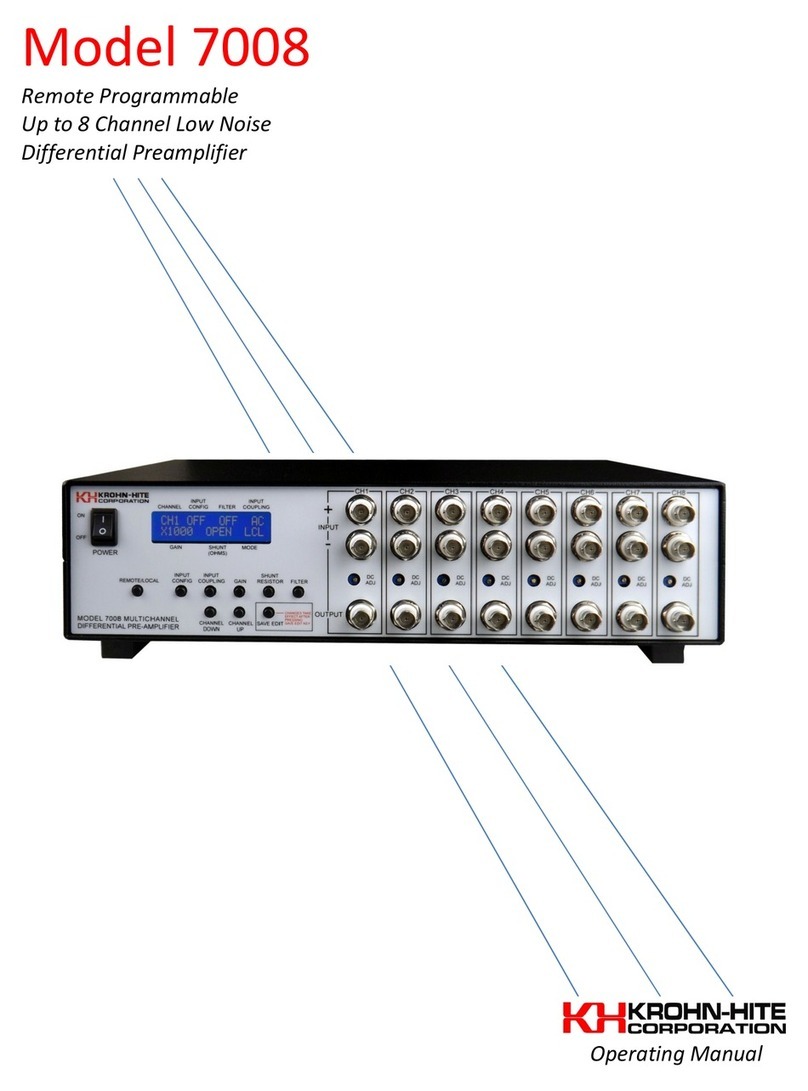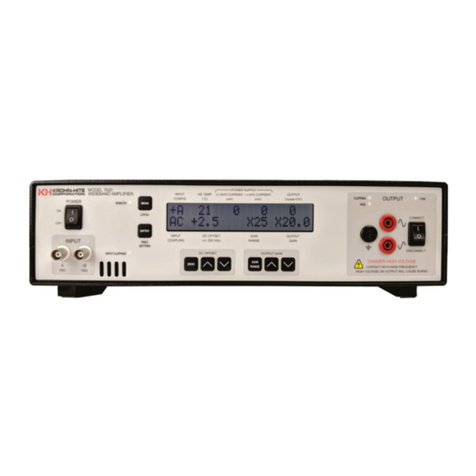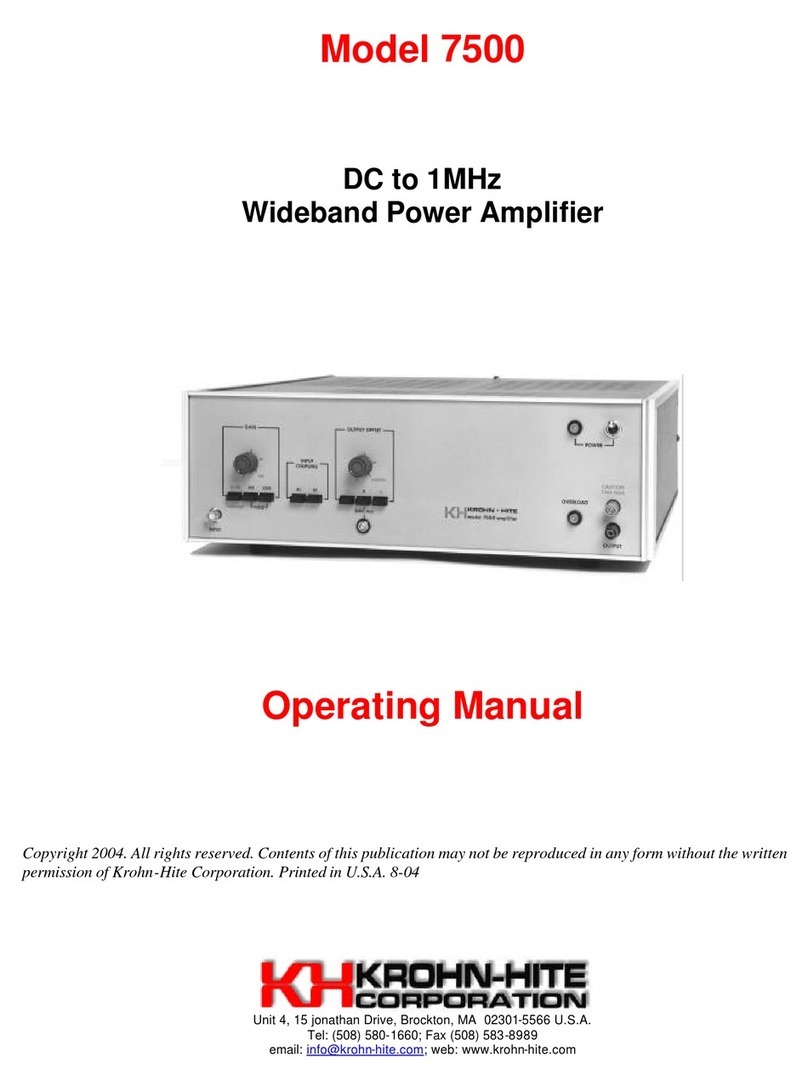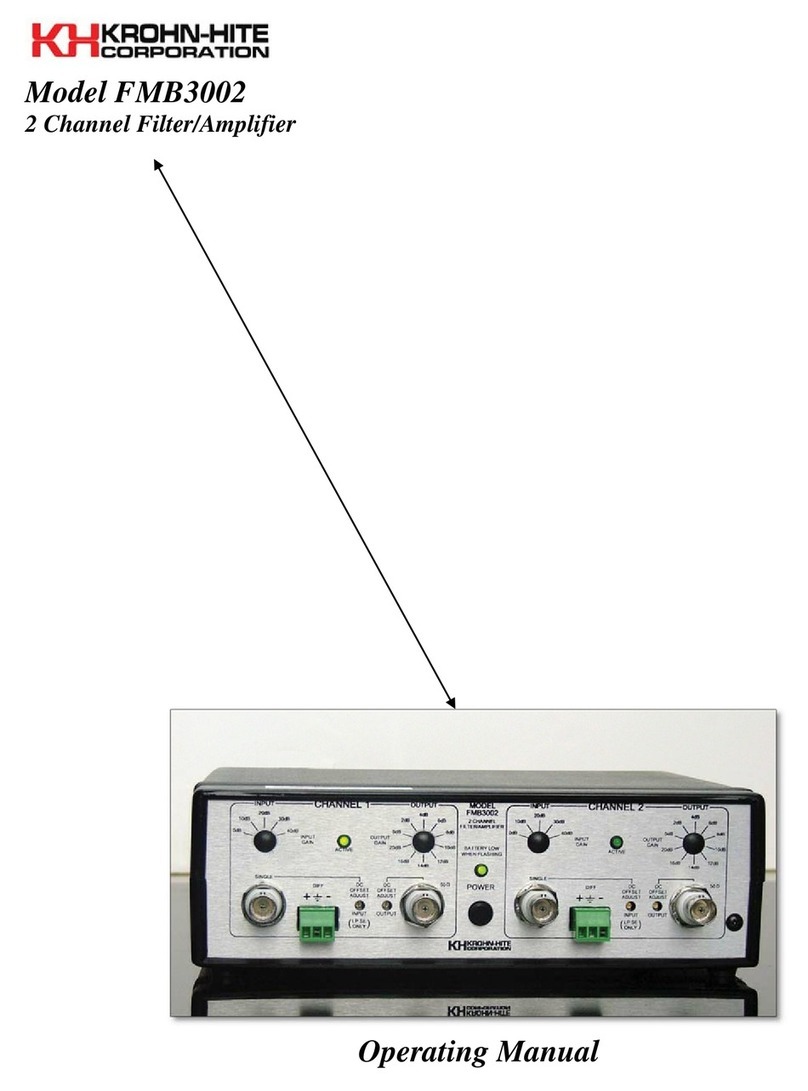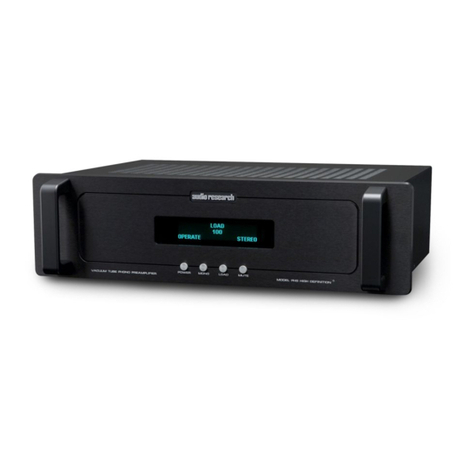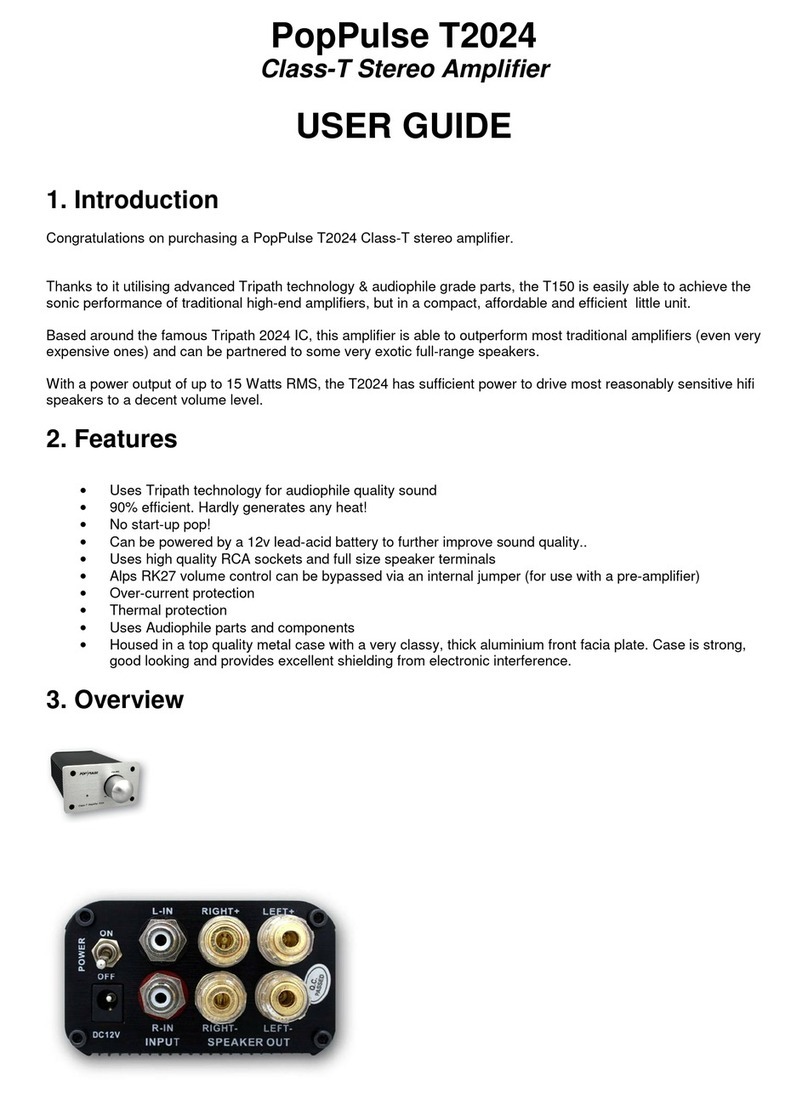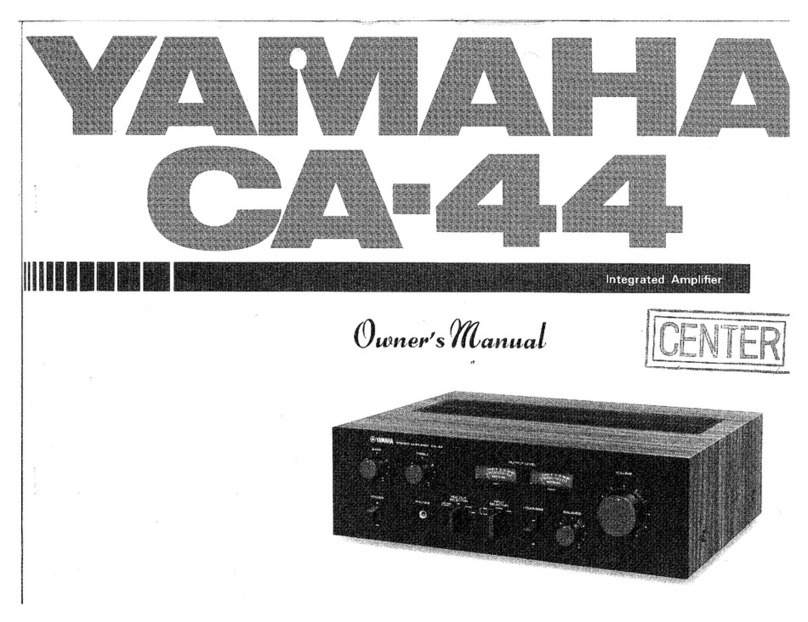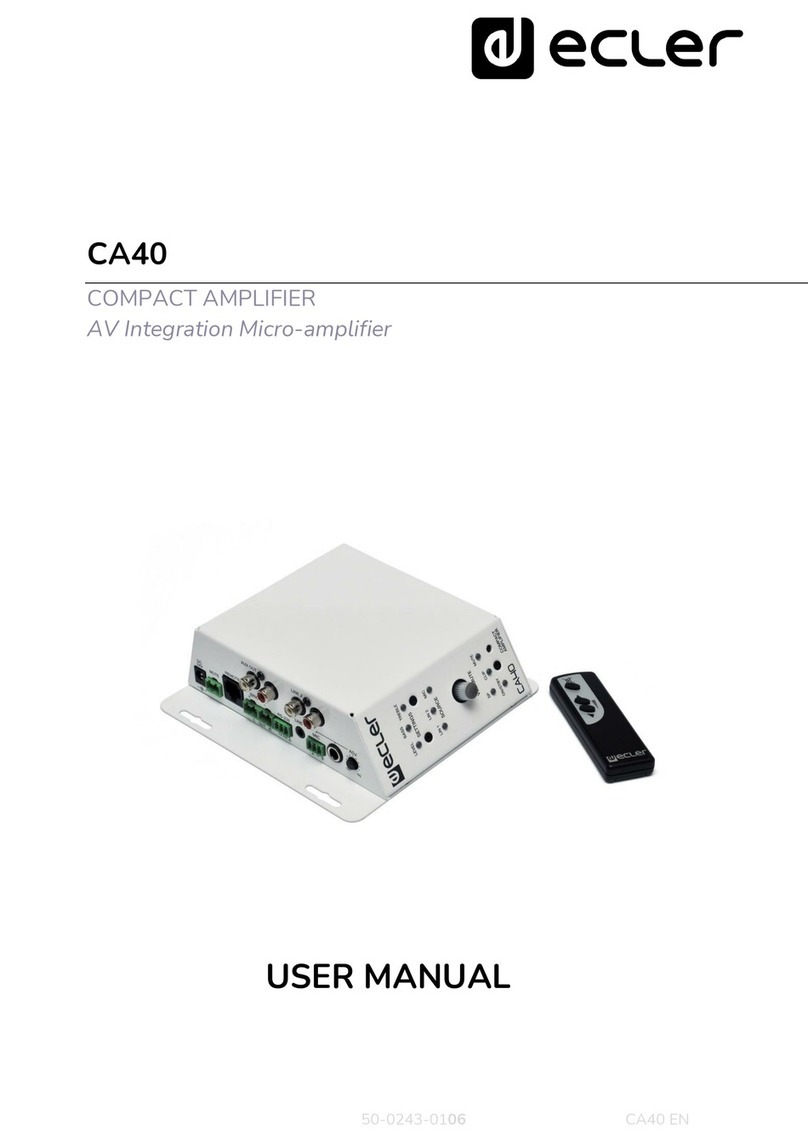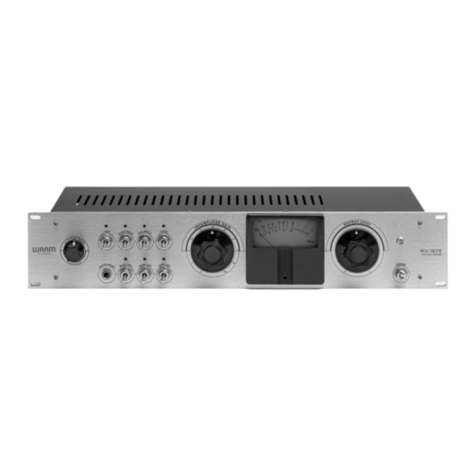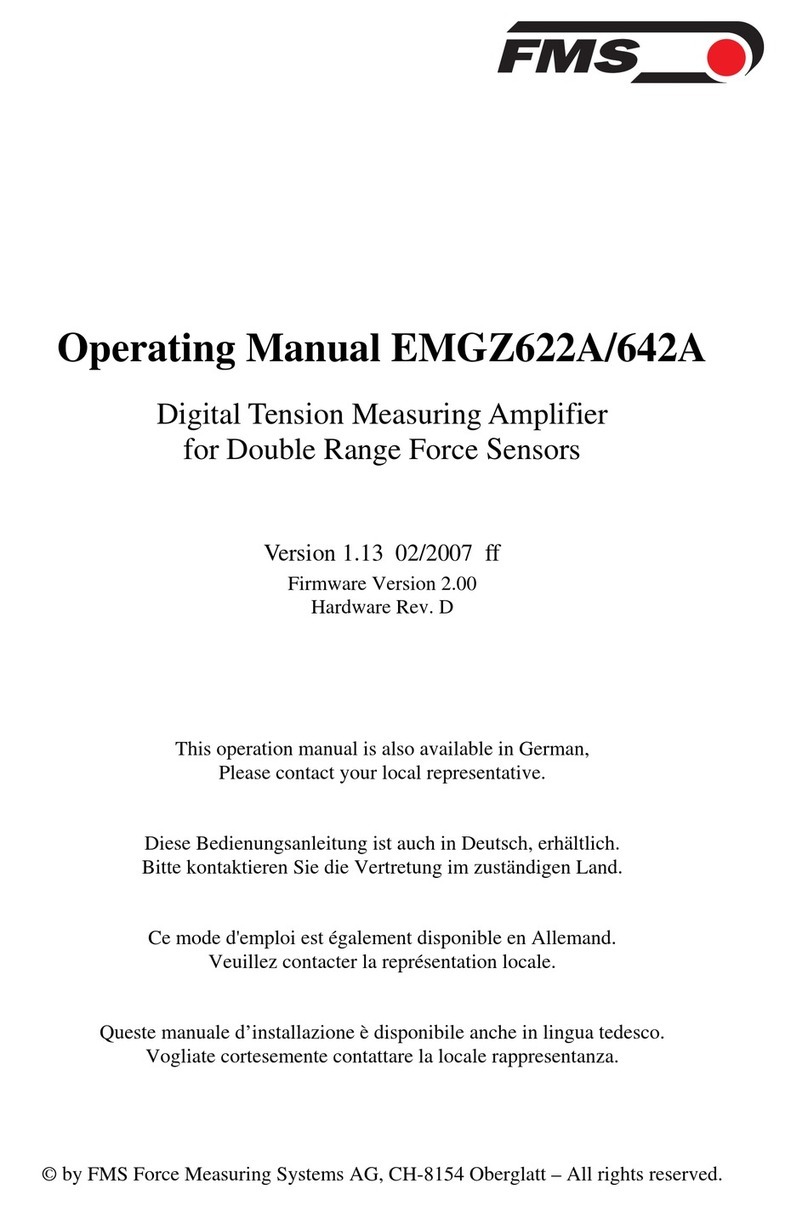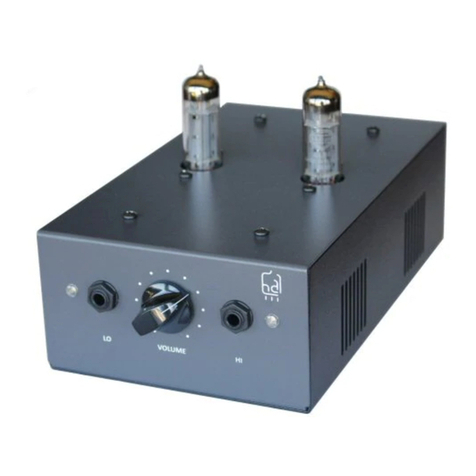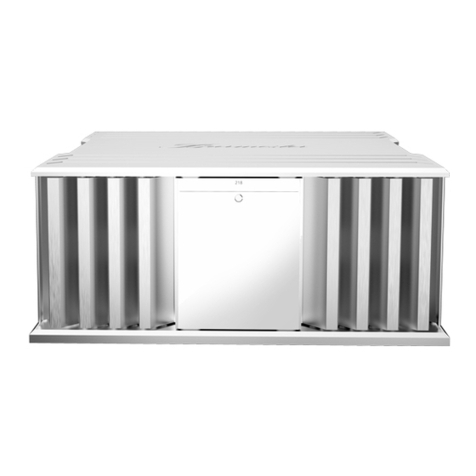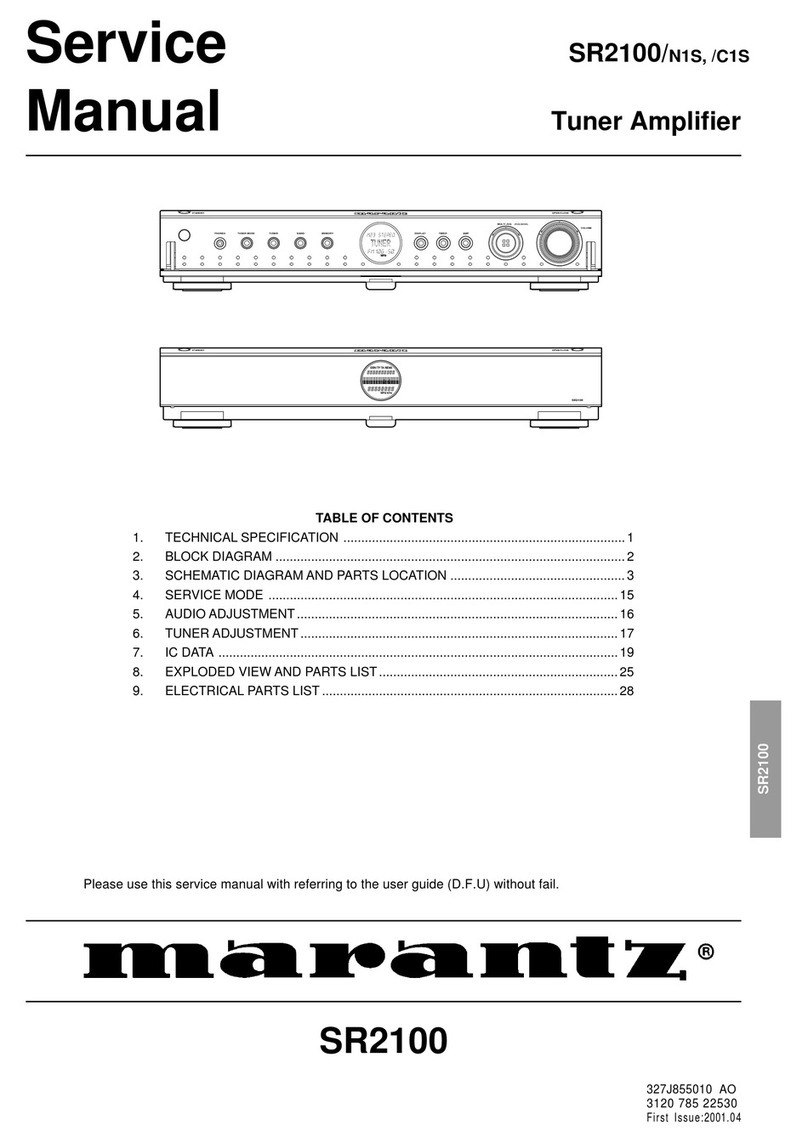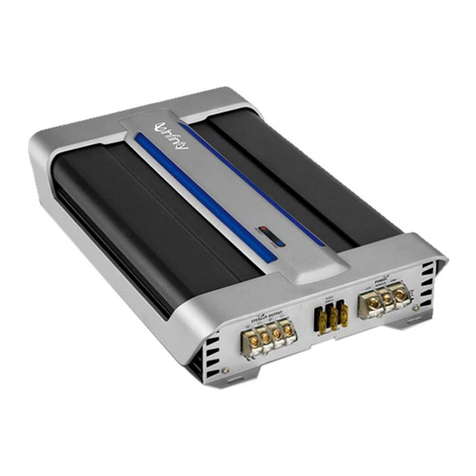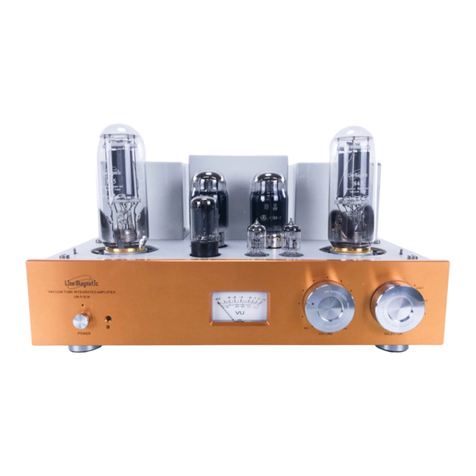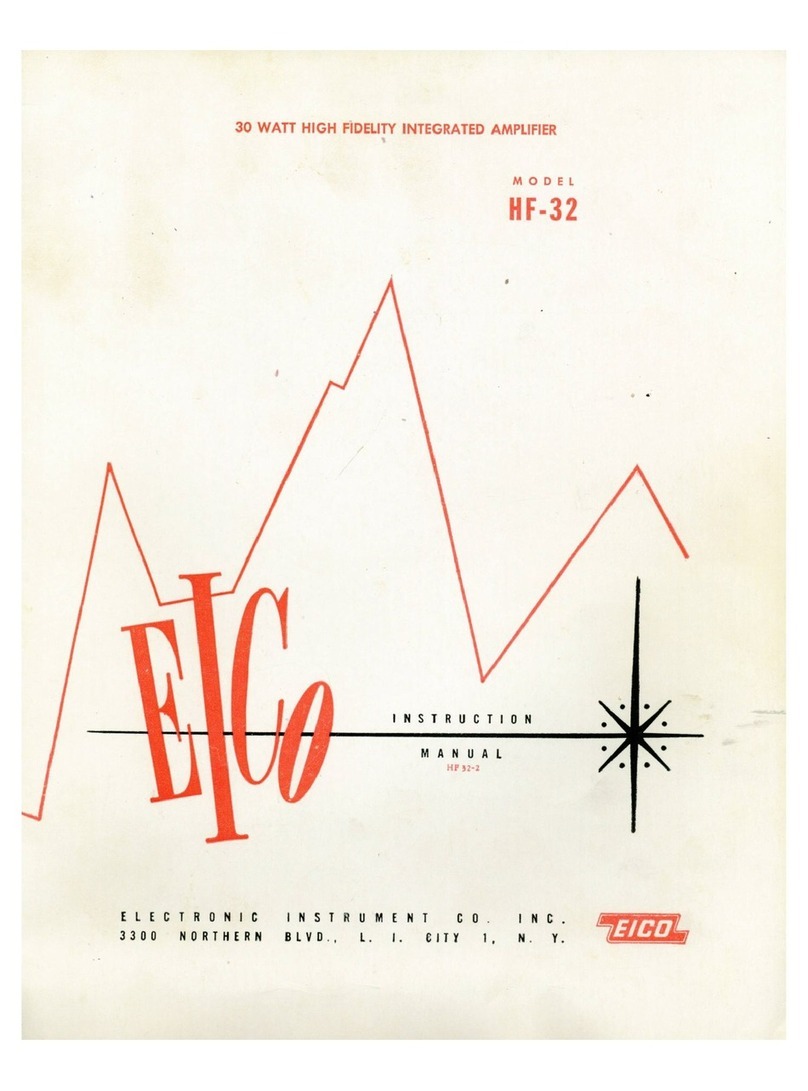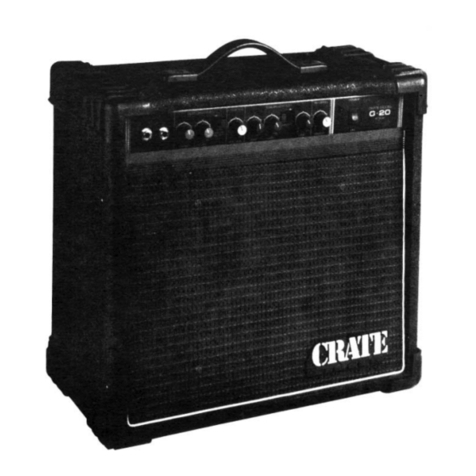Krohn-Hite 7600 Operating instructions

Model 7600(M)/7602(M)
Wideband Power Amplifier
DC to 1MHz
141V/282V rms
17/34 Watts
Operating and Maintenance Manual

Service and Warranty
Krohn-Hite Instruments are designed and manufactured in accordance with sound engineering practices
and should give long trouble-free service under normal operating conditions. If your instrument fails to
providesatisfactoryserviceand youare unabletolocate thesourceoftrouble, contactourService Depart-
ment at (508) 580-1660, giving all the information available concerning the failure.
DO NOT return the instrument without our written or verbal authorization to do so. After contacting us,
we will issue a Return Authorization Number which should be referenced on the packing slip and pur-
chase order. In most cases, we will be able to supply you with the information necessary to repair the in-
strument,avoidinganytransportationproblemsandcosts.Whenitbecomesnecessarytoreturntheinstru-
ment to the factory, kindly pack it carefully and ship it to us prepaid.
All Krohn-Hite products are warranted against defective materials and workmanship. This warranty ap-
plies for a period of one year from the date of delivery to the Original Purchaser. Any instrument that is
found within the one year warranty period not to meet these standards, will be repaired or rep laced. This
warrantydoesnotapplytoelectrontubes,fusesorbatteries.Nootherwarrantyisexpressedorimplied.
Krohn-HiteCorporationreserves theright tomake designchanges atany timewithout incurringany obli-
gation to incorporate these changes in instruments previously purchased.
Modificationstothis instrumentmustnot bemade without the writtenconsent of an authorized employee
of Krohn-Hite Corporation.

Model 7600(M) and 7602(M)
Wideband Power Amplifier
DC to 1MHz, 17W and 34W
Serial No. ___________________________
Operating and Maintenance Manual
15 Jonathan Drive, Unit 4
Brockton, MA 02301-5566 U.S.A.
Tel: (508) 580-1660; Fax: (508) 583-8989
Email: [email protected]
Service: ser[email protected]
www.krohn-hite.com
Copyright 2004 Krohn-Hite Corporation. All rights reserved.
Contents of this publication may not be reproduced in any form
without the written perrmission of Krohn-Hite Corporation.
Printed 5-04, Rev 3.1

Model 7600M ("M" is the Meter Option Package)
Model 7602M ("M" is the Meter Option Package)
Model 7600
Model 7602

Table of Contents
1.0 GENERAL DESCRIPTION ···························1-1
1.1 INTRODUCTION···································1-1
1.1.1 Shipping to Krohn-Hite for Repair or Calibration..........1-1
1.2 SPECIFICATIONS ··································1-1
1.2.1 OUTPUT (All rms values are for sinewave signals).........1-1
1.3 INPUT··········································1-3
1.4 GENERAL ·······································1-3
1.5 OPTIONS········································1-4
2.0 OPERATION ····································2-1
2.1 INTRODUCTION···································2-1
2.2 POWER REQUIREMENTS·····························2-1
2.3 TURN-ON PROCEDURE ······························2-1
2.4 OPERATION······································2-3
2.4.1 Front Panel ..................................2-3
2.4.1.1 PowerSwitch·······························2-3
2.4.1.2 Mode ···································2-3
2.4.1.3 AC/DCCoupling·····························2-3
2.4.1.4 GaindB··································2-4
2.4.1.5 VariableGaindBControl·························2-4
2.4.1.6 DCOffset·································2-4
2.4.1.7 VariableDCOffsetControl························2-4
2.4.1.8 MeterSelectSwitch(MeterOption) ···················2-4
2.4.1.9 Connectors ································2-5
2.4.1.10 OutputDisconnect/ConnectSwitch···················2-5
2.4.1.11 LEDIndicators ·····························2-5
I

2.4.2 Rear Panel ...................................2-5
2.4.2.1 Option002Connectors··························2-5
2.4.2.2 Chassis/FloatingGroundSwitch ·····················2-5
2.4.2.3 FuseReceptacle ·····························2-6
2.4.2.4 ACPowerReceptacle ··························2-6
2.4.2.5 LineSwitches ······························2-6
3.0 INCOMING ACCEPTANCE···························3-1
3.1 INTRODUCTION···································3-1
3.2 TEST EQUIPMENT REQUIRED ·························3-1
3.3 INCOMING PROCEDURE ·····························3-1
3.3.1 DC Offset and Peak Volts Meter Calibration Check.........3-1
3.3.2 Squarewave Broad Banding Check ...................3-2
3.3.3 Squarewave Rise And Fall Time Check.................3-3
3.3.4 Slew Rate Check ...............................3-3
3.3.5 Gain Calibration Check ..........................3-4
3.3.6 Frequency Response Check ........................3-4
3.3.7 1K Load Maximum Power .........................3-5
3.3.8 Distortion Check...............................3-6
ii

SECTION 1
GENERAL DESCRIPTION
1.1 INTRODUCTION
The Model 7600 and 7602 are 17 watt and 34 wattwideband power amplifiers that offer extended output
power and voltage capabilities, low distortion, versatility and the latest in hybrid CMOS power opera-
tional amplifier technology, with performance features not available in other power amplifiers.
Theunitprovides17wattsofcontinuous power(34wattsatdc)and141Vrmsfromdcto500kHz.Thefre-
quency response is ±0.1dB to 10kHz, and the distortion contributed by the amplifier is <0.01% to 5kHz
and<0.3%to 100kHz.The voltagegain canbe eitherinverting ornon-inverting and hasselectableranges
from0dBto14dB,14dBto 28dBand28dBto42dB(avoltagegainstepof5),andiscontinuouslyvariable
between the ranges.
Otherfeaturesinclude:modesofA,A–Band–B;commonmoderejectionof80dB;inputcouplingof acor
dc; a meterthatis selectableto display heat sink temperatures in °C, outputpeak voltageand average out-
put current. A dc offset control is also provided that is variable from 0V to ±200V.
TheModel7602providesthesamecapabilitiesastheModel7600but alsoprovidesabalanced outputand
isableto deliver 34 watts of continuous power (68 watts at dc), and 282V rms (800V p-p). It can also pro-
vide plus and minus voltages simultaneously.
Claim for Damage in Shipment to Purchaser
The Model 7600 and 7602 are carefully inspected, tested and aged before shipment to ensure that it is
working properly. The unit should be thoroughly inspected immediately upon arrival to purc haser. All
itemsshippedshould bechecked againstthe enclosedpacking list. Krohn-Hitewill not beresponsible for
shortages against the packing list unless notified immediately. If for some reason the instrument is not
workingproperly,orappears tohave beendamaged inshipment,inform thefreight carrierandfilea claim
for the damage, then notify Krohn-Hite or its nearest sales office immediately (to obtaina quotation to re-
pairtheshipmentdamage).Thefinalclaimandnegotiationswiththecarriermustbecompletedbythecus-
tomer.
1.1.1 Shipping to Krohn-Hite for Repair or Calibration
All shipments of Krohn-Hite instruments should be made via United Parcel Service or “Best Way” pre-
paid.The instrumentshould beshippedintheoriginal shippingcontainer; orif notavailable, use any suit-
able container that is rigid and of adequate size. If a substitute container is used, the unit should be
wrapped in paper and surrounded with at least four inches of shock-absorbing material.
Model 7600/7602 Section 1 - General Description
1-1

1.2 SPECIFICATIONS
1.2.1 OUTPUT (All rms values are for sinewave signals)
For the Model 7602, specifications apply to each output to ground.
Frequency Range: dc to 1MHz.
Power
1k Ohm Load: 17W rms, 34W dc and peak, dc to 500kHz; 5W rms to 1MHz.
600 Ohm Load: 10W rms, 100Hz to 1MHz; 5W rms, 10W dc and peak, dc to 100Hz.
Voltage
No Load: ±200V dc and peak, 141V rms.
1k Ohm Load: ±184V dc and peak, 130V rms, dc to 500kHz; ±113V peak, 80V rms at 1MHz.
600OhmLoad:±113Vpeak,80Vrms,100Hzto1MHz;±78Vdcandpeak,55Vrms,dcto100Hz.
Current: 910 ohm load, ±200mA peak, 141mA rms, dc to 500kHz.
Frequency Response: ±0.1dB, dc to 10kHz; ±0.25dB to 200kHz; ±0.5dB to 500kHz, 0-130V rms;
±0.5dB to 1MHz 0-80V rms.
HarmonicDistortion:<0.01%to5kHzand175Vpeakoutput;<0.05%to200Vpeak;<0.3%to100kHz.
Voltage Gain: 0dB to 42dB in three ranges; 0dB to 14dB, 0dB to 28dB, 0dB to 42dB; continuously vari-
able between ranges.
Step Accuracy: ±0.1dB plus frequency response specification. Gain steps are 14dB at max variable
gain control setting or a voltage gain of 5.
Stability: <0.001dB change for a 10% change in line voltage.
Dynamic Range: >80dB.
Hum and Noise (2MHz bandwidth): referred to output, <10mV rms; <20mV rms on the 0dB to 42dB
gain range.
Phase Shift: A input 0° ±1°, B input, 180° ±1° dc to 10kHz increasing linearly 60° lagging at 1MHz.
Model 7602: (Inverted output relative to non-inverted) 180°, –0.3° at 10kHz; 180°, –3° at 100kHz; 180°,
–20° at 1MHz.
Squarewave Response
Rise/Fall Times: 120ns to 50Vp-p.
Slew Rate: >600V/ms, 400Vp-p.
Aberrations: <5%.
Section 1 - General Description Model 7600/7602
1-2

Regulation: <0.1%, No load to 1k ohm load, dc to 10kHz, rising to 2% at 1MHz.
Coupling: DC.
DC Level: Nominal zero volts; vs. temperature, 2mV/°C.
DC Offset Control (no load): 0V to ±200V.
DC Level Stability
Vs. Line: <1mV for a 10% change in line voltage.
Vs. Temperature: <0.01%/°C or 2mV/°C whichever is greater.
Internal Impedance: <0.5 ohms, dc to 10kHz; 5 ohms at 100kHz; 20 ohms at 1MHz.
OutputProtection:Protected from overloads with a uniquefoldbacklimiterwhichkeeps theoutput cur-
rent within safe operating regions. Kickback diodes clamp kickback voltages to the supply.
1.3 INPUT
Modes: A, A–B, –B.
Maximum Voltage (without damage): ±200V dc referred to ground.
Maximum Common Mode: 0dB to 14dB range, ±200V peak; 14dB to 28dB range, ±40V peak; 28dB to
42dB range, ±8V peak.
CommonModeRejection:80dB,dcto200Hz;60dBto1kHz;40dBto10kHz;risingto20dBat1MHz.
Sensitivity: ±1.6V peak.
Coupling: Direct (dc) or capacitive (ac) with low frequency cutoff of approximately 1Hz.
Impedance: 1Megohm inparallel with30pF withfront inputsonly; 65pFwith frontand optional rear in-
puts, independent of input gain setting.
1.4 GENERAL
Load Impedance: Capable of driving any resistive load within the current and voltage limitations of the
amplifiers foldback limiter. Capable of driving reactive loads within voltage and current limitations.
Temperature Range: 0°C to 45°C.
Controls
Front panel:Power switch, 5-position input MODE switch, 2-position INPUT COUPLING switch,
3-position GAIN controlswitch, variableGAIN dBpotentiometer, 10-turnvariable DCOFFS ET po-
tentiometer, 3-position offset RANGE switch, 4-position METER SELECT switch, output CON-
NECT/DISCONNECT switch.
Rear panel: CHASSIS/FLOAT GROUND switch.
Section 1 - General Description
1-3

Front Panel Warning LED Indicators: Over TEMP, CLIPPING, output H.V. (high voltage).
Terminals: BNC A input, BNC B input, binding post output.
Rear Panel: Power receptacle, optional BNC A input, B input and binding post output.
Power Requirements: 90-132/198-264 volts, 50Hz-400Hz, 200 watts.
Dimensionsand Weights: 312“ (9cm) high, 812” (21.8cm) wide, 18" (46ttttttttt.2cm) deep; 12 lbs (5.4kg)
net, 14 lbs (6.3kg) shipping.
Accessories: 3-terminal line cord, operating manual.
1.5 OPTIONS
7600M/7602M Meter - Option Package
HeatSink Temp °C: Measuresthe heatsinktemperaturein thevicinityoftheoutputpoweramplifier
IC. Used as an indicator of operating conditions and air flow to the unit.
Output Peak Voltage: Measures the largest peak voltage independent of polarity with a 1 second
time constant.
Accuracy (at 1kHz): ±0.5V.
Frequency Response: ±2%, 10Hz to 100kHz; 5% to 1MHz.
Average Output Current: Measures average dc supply current delivered to the output amplifier as
an indicator of output amplifier load. Quiescent current is nulled out. Can be used to find resonances
in a load.
Accuracy: ±5% ±1 digit.
Rack Mounting Kit: Part No. RK-37, permits installation of the Models 7600/7602 into a standard 19"
rack spacing.
Option 003: Rear panel input and output connectors.
Section 1 - General Description
1-4

SECTION 2
OPERATION
2.1 INTRODUCTION
This section describes the operation of the Model 7600 and 7602. It includes the proper ac requirements,
the recommended turn-on procedure and a detailed explanation of all the operating controls.
2.2 POWER REQUIREMENTS
TheModel7600 and7602PowerAmplifier is designedtooperatefromasingle-phase, 50Hz to400Hzac
power source of 90 to 110, 108 to 132, 198 to 242 or 216 to 264 volts. The LINE SWITCH located onthe
rearpanel allows the unit to be powered from one of the four voltagerangesabove. Theac powerrecepta-
cleisastandard 3-pinconnectorandcomplieswiththeEuropean I.E.C.standard.Adetachable3-wireline
cord is provided with the unit.
2.3 TURN-ON PROCEDURE
1. Set the LINE SWITCHES for the desired range.
For the 90 to 110 volt range, set the voltage range switch to 120V and the NORM/LOW switch to
LOW.
For the 108 to 132 volt range, set the voltage range switch to 120V and the NORM/LOW switch to
NORM.
For the 198 to 242 volt range, set the voltage range switch to 240V and the NORM/LOW switch to
LOW.
For the 216 to 264 volt range, set the voltage range switch to 240V and the NORM/LOW switch to
NORM.
2. Observe that the POWER switch is in the off position.
3. Toselectthedesired grounding,switch theCHASSIS/FLOATING GROUNDslideswitchlocated on
the rear panel to the proper setting.
WARNING
ThechassisoftheModel7600and7602canbeconnectedtosig-
nalgroundvia theCHASSIS/FLOATING GROUNDswitch. For
safetypurposes,connectthelinecordtoa3-terminalacoutlet.
2-1
Section 2 - Operation

4. Plug the line cord into the unit and then into the ac outlet.
5. Turn the POWER switch on and allow the unit to warm-up for several minutes.
CAUTION
Because of potentially dangerous voltage
within the Model 7600 and 7602, the covers
should not be removed when the unit is con-
nected to an ac outlet, unless it is by qualified
personnel.
The Model 7600 and 7602 is now ready to amplify.
2.4 OPERATION
To operate the Model 7600 and 7602 Power Amplifier, proceed as follows:
1. Make the appropriate power connections ( refer to TURN-ON Procedure).
2. Set the DC OFFSET switch to the OFF position.
3. Set the GAIN dB switch to 0dB.
4. Set the MODE switch to OFF.
5. Set the Input Coupling switch to the desired mode (AC or DC).
6. Set the METER SELECT switch to the PEAK VOLTS position.
7. Connect a voltmeter to the OUTPUT terminals and check for 0V dc.
Allow the unit to warm-up for 30 minutes to obtain rated performance specifications.
CAUTION
The Model 7600 and 7602 is capable of as much as 200V peak
(7600)and 400Vpeak(7602) onitsOUTPUT terminals. To pre-
ventthe possibilityof electricalshock,set theOUTPUTconnect
switchtoDISCONNECTwhenconnectingordisconnecting any
cable or load from the amplifier’s OUTPUT terminals.
2-2
Section 2 - Operation

2.4.1 Front Panel
2.4.1.1 Power Switch
“I” is the ON position, “0” is the OFF position.
2-3
Section 2 - Operation
Figure 2.2 Model 7602M with Meter Option Package
Figure 2.1 Model 7600M with Meter Option Package

2.4.1.2 Mode
The MODE selector switch consists of a 5-position, rotary switch that selects the Mode of operation. The
following are a description of each position:
OFF: When selected, there will be no signal at the OUTPUT terminals.
A: When selected, the input signal will be non-inverted (in-phase) at the (sinewave)
OUTPUT terminal and inverted at the (inverted sinewave)
OUTPUT terminal.
–B: When selected, the input signal will be inverted at the (sinewave) OUTPUT
terminal and non-inverted at the (inverted sinewave) OUTPUT terminal.
A–B: When selected, the output signal will be the mathematical difference between
each input signal.
2.4.1.3 AC/DC Coupling
The AC/DC switch is a 2-position rotary switch with two selectable setting: AC (capacitive coupling) or
DC (direct coupling). In the AC position, the low-cutoff frequency is approximately 1Hz.
2.4.1.4 Gain dB
The GAIN dB switch consists of a 3-position rotary switch with three ranges. A minimum signal of 1.6V
peakmustbeappliedtotheinputinordertoobtain themaximumoutputvoltageof200Vpeak.When used
with the variable GAIN control, each position can be varied as follows:
0dB:0dB to 14dB
14dB::0dB to 28dB
28dB::0dB to 42dB
2.4.1.5 Variable Gain dB Control
The Variable Gain dB Control is a single-turn potentiometer that has an overall gain of 5at each range of
the GAIN dB range switch described in paragraph 2.4.1.2 above.
Note
When the VariableGaindB Controlis inthe maximumCCW position, the am-
plifier’soutput terminalswill stillhaveavoltageorsignal onthem.Inorderto
not have this condition occur, the MODE switch must be set in the OFF posi-
tion, the Output DISCONNECT/CONNECT switch must be set to the DIS-
CONNECT position, or the input signal must be removed.
2.4.1.6 DC Offset
The DC OFFSET switch consists of a 3-position rotary switch with three selectable settings: –200, OFF
and+200.When usedwiththevariableDCOFFSETcontrol,thedcoffsetcanbevariedfrom0Vto –200V
dc and 0V to +200V dc.
2-4
Section 2 - Operation

2.4.1.7 Variable DC Offset Control
The Variable DC OFFSET Control consists of a 10-turn potentiometer that infinitely cont rols the Output
DC Offset 0V to –200V peak or 0V to +200V peak.
2.4.1.8 Meter Select Switch (Meter Option)
The Meter Select Switch is a 4-position rotary switch that allows the LED panel meter to indicate the fol-
lowing:
Heat Sink Temp °C:Indicates the temperature of the heat sink at the output amplifiers.
It gives the user a monitoring device when the amplifier is in an
environment that is not well ventilated.
Peak Volts:Indicates the output peak voltage.
Average (I) +Supply:Indicates the average current of the plus supply.
Average (I) –Supply:Indicates the average current of the minus supply.
2.4.1.9 Connectors
BNCconnectorsareprovidedfortheInputsignal,andBindingPostsareprovidedfortheOutputsignal.
A Input BNC: Sensitivity is 1.6V peak. A signal of ±1.6V peak is needed to achieve maximum output.
Active when the MODE switch is selected to the A or A–B positions.
B Input BNC: Sensitivity is 1.6V peak. A signal of ±1.6V peak is needed to achieve maximum output.
Active when the MODE switch is selected to the –B or A–B positions.
2.4.1.10 Output Disconnect/ Connect Switch
“I” is the ON position, “0” is the OFF position.
2.4.1.11 LED Indicators
Temp: Indicates the heat sink temperature has exceeded 57°C (with Meter option Package only).
Clipping:Indicates when the output is beginning or actually clipping.
>15V: Indicates when the output voltage is >15V (with Meter Option Package only).
2-5
Section 2 - Operation

2.4.2 Rear Panel
2.4.2.1 Option 002 Connectors
BNCconnectorsareprovidedfortheInputsignal,andBindingPostsareprovidedfortheOutputsignal.
2.4.2.2 Chassis/Floating Ground Switch
TheCHASSIS/FLOATING GROUNDswitch isa2-position slideswitchthatdisconnectsthe amplif ier’s
signal ground from its chassis ground when used in the FLOATING mode.
2.4.2.3 Fuse Receptacle
The amplifier’s fuse rating is a 3A slow-blow for both 120V and 230V operation.
2.4.2.4 AC Power Receptacle
The AC power receptacle is a standard 3-wire AC connector.
2.4.2.5 Line Switches
A description of the AC line switches are in paragraph 2.3.
2-6
Section 2 - Operation
Figure 2.1Rear Panel Panel

SECTION 3
INCOMING ACCEPTANCE
3.1 INTRODUCTION
Thefollowing procedureshould beusedtoverifythat theModel7600 and7602isoperatingwithin speci-
fications., both for incoming inspection and routine servicing. Tests should be made with the covers in
place, and the procedure given below should be followed in sequence.
3.2 TEST EQUIPMENT REQUIRED
a. DC volt meter capable of measuring 1mV to 200V with 0.1% accuracy at 200V. Fluke Model 8010A
or equivalent.
b. AC Voltmeter capable of measuring 100mV to 150V rms with a 1MHz bandwidth. Fluke Model
8920A rms volt meter or equivalent.
c. Dual Channel Oscilloscope with X10 probes and a 50MHz bandwidth. Tektronix Model 2245A or
equivalent.
d. 1000 ohm dummy load capable of dissipating 40 Watts.
e. Sinewave source from 10Hz to 1MHz. Krohn-Hite Model 4200B/4300B or equivalent.
f. Sinewave source with <0.01% distortion at 1kHz. Krohn-Hite Model 4400A or equivalent.
g. Squarewave source from 1kHz to 200kHz with 40ns rise and fall time and 5% aberrations.
Krohn-Hite Model 4300 or equivalent.
h. Distortion analyzer that can measure down to 0.005%. Krohn-Hite Model 6900B or equivalent.
In the following procedure the main output is marked with a sinewave and the inverted output is marked
with an inverted sinewave on the front panel.
3.3 INCOMING PROCEDURE
3.3.1 DC Offset and Peak Volts Meter Calibration Check
Set the MODE to OFF.
Set METER SELECT to PEAK VOLTS.
Connect the DVM to the main output.
Set the DC OFFSET control to +200 position.
Adjust the offset control pot for a +199.0V reading on the DVM.
3-1
Section 3 - Incoming Acceptance

The 7600/7602 meter should read 199.0V ±0.5V.
For the 7602 measure the inverted output for –199.0V ±0.4V.
Set the DC OFFSET to –200 position.
Adjust the offset control pot for a –199.0V reading on the DVM.
The 7600/7602 meter should read 199.0V ±0.5V.
The High Voltage LED should be lit and the CLIPPING LED out for both polarities of output offset.
Reduce the DC offset using the offset control pot until the HV LED goes out.
The voltage it goes out at should be 12V to 15V.
Disconnect the DVM from the 7600/7602.
3.3.2 Squarewave Broad Banding Check
The CLIPPING LED should not come on during steps 2 and 3.
Connect a 1kHz, 2.0V p-p (1.0V peak) squarewave to the A and B inputs.
Set the oscilloscope gain for 0.5V/cm with probes on both channels.
Connectbothoscilloscope channelsone andtwo throughX10 probes(probe mustbe broadbanded) tothe
input signal and adjust them to give an optimum matched waveform.
Connect oscilloscope channel two to the main output.
Set scope gain on channel two to 10V/cm, DC coupled.
Set the 7600/7602 for AC coupling and a gain of 28dB (GAIN dB to 28, gain pot to 0 end stop),
MODE to A.
The waveform on the oscilloscope should be 50V p-p (5 cm).
Waveformaberrationssuchasdroop,slantorovershootshouldbelessthan2.5Vor0.25cm.Adjusttheos-
cilloscopevariable gaincontrol knobso thatthe outputamplitude displayed matches the inputamplitude.
The two waveforms should look the same within 0.2cm.
Set the MODE to –B.
Set the oscilloscope channel two invert on.
The two waveforms should look the same within 0.2cm.
Set the GAIN dB for 14.
Set the channel one gain to 2V/cm.
Set the 1kHz square waveform amplitude to 10.0V p-p (5.0V peak).
Readjust the oscilloscope channel two variable gain control so that the output amplitude displayed
matches the input amplitude.
The two waveforms should look the same within 0.2cm.
3-2
Section 3 - Incoming Acceptance

Set the MODE to A.
Set the oscilloscope channel two invert off.
The two waveforms should look the same within 0.2cm.
Set the GAIN dB for 0, gain control pot to 0 end stop.
The two waveforms should look the same within 0.2cm.
Set the MODE to –B.
Set the oscilloscope channel two invert on.
The two waveforms should look the same within 0.2cm.
For the 7602 connect the scope to the inverted output.
Set the oscilloscope channel two invert off.
The two waveforms should look the same within 0.2cm.
Reconnect the scope to the main output.
3.3.3 Squarewave Rise And Fall Time Check
Connect the scope probe to the main output and set it’s gain for 10V/cm, variable gain control pot to cal.
position.
Set the input squarewave frequency to 200kHz.
Set the input amplitude to 2.0V p-p (1.0V peak).
Set the 7600/7602 GAIN dB for 14, amplitude control pot to 14 end stop.
Set the scope sweep time to 0.5mS/cm.
Set the scope for negative slope trigger.
One full cycle of a 50V p-p square wave should be on the screen with the rising edge in the cent er of the
screen. The waveform aberrations should be <5% or 2.5V (14cm).
Set the sweep X10 magnifier on and recenter the rising edge using the horizontal position control.
Measure the rise time from the 10% to the 90% points on the rising edge.
It should be <120ns (2.4cm).
Set the scope trigger to positive slope.
Locate the falling edge using the horizontal position control.
Measure the fall time from the 90% to the 10% points on the falling edge.
It should be <120nsec (2.4cm).
For the 7602 repeat the step for the inverted output.
3-3
Section 3 - Incoming Acceptance

3.3.4 Slew Rate Check
Set the MODE to A.
Set the GAIN dB for 28, gain control pot for 0 end stop.
Set the scope sweep X10 magnifier to off.
Set the scope gain to 50V/cm.
Set the sweep time to 1mS/cm.
Set the input squarewave frequency to 200kHz.
Set the input amplitude to 3.0V p-p.
The output amplitude should be 375V p-p.
Set the sweep X10 Mag on.
Measure the rising edge slew time from the –150V point on the scope (3rd cm below center line) to the
+150V point (3rd cm above center line).
It should be mS (5cm).
Set the scope trigger slope to negative.
Measure the falling edge slew time from the +150V point on the scope (3rd cm above center line) to the
–150V point (3rd cm below center line).
It should be <0.5mS (5cm).
For the 7602 repeat the step for the inverted output.
3.3.5 Gain Calibration Check
Set the input waveform to sine wave and connect it to both A and B inputs using two T adapters.
Set the input signal to a 1kHz.
Set the input amplitude to 1V p-p.
Connect the scope to the output(s) set for a gain of 20V/cm.
Connect the Fluke model 8920A true RMS voltmeter to the input via a T adapter.
Set it for dB relative operation.
Zero reference the meter.
Set the 7600/7602 for:
MODE –B and AC.
GAIN dB to 28 and gain control pot to 0 end stop.
DC OFFSET OFF.
METER SELECT to PEAK VOLTS.
3-4
Section 3 - Incoming Acceptance
This manual suits for next models
3
Table of contents
Other Krohn-Hite Amplifier manuals

